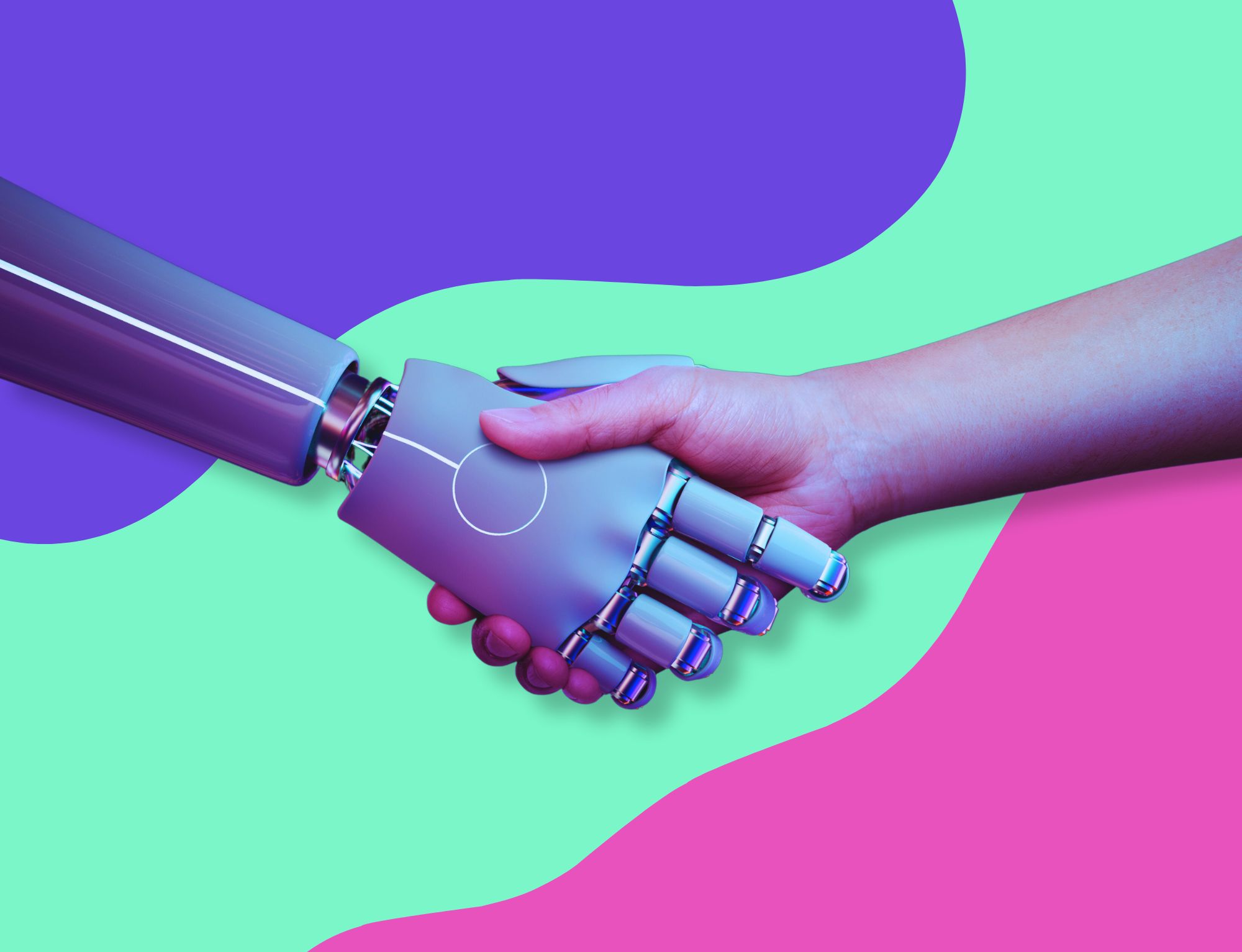What you’ll learn
With the AI content boom of 2023 comes the vital need to produce authentic, transparent, and honest content. But as brands scramble to update their terms to reflect their stance on AI-generated content, they’re flocking to AI detectors to decipher the human touch from artificially-constructed gibberish.
Bottom line? It’s messy. And we wondered how well AI detectors could rise to the task.
Today, we’ll dive headfirst into the world of AI detection tools, putting the capabilities of five industry favorites to the test and uncovering more ways to protect your content’s integrity and authenticity.
In this comprehensive exposé, we’ll analyze:
- What AI content detection tools are
- How five leading free AI detection tools measure up
- The best ways to dodge penalties and publish epic content
- Expert insights courtesy of Christina Lyon, the alpha of our pack 🦁
- How to decode the results and use the data to safeguard your content’s integrity
Ready to fall down the rabbit hole? Let’s take a dip.
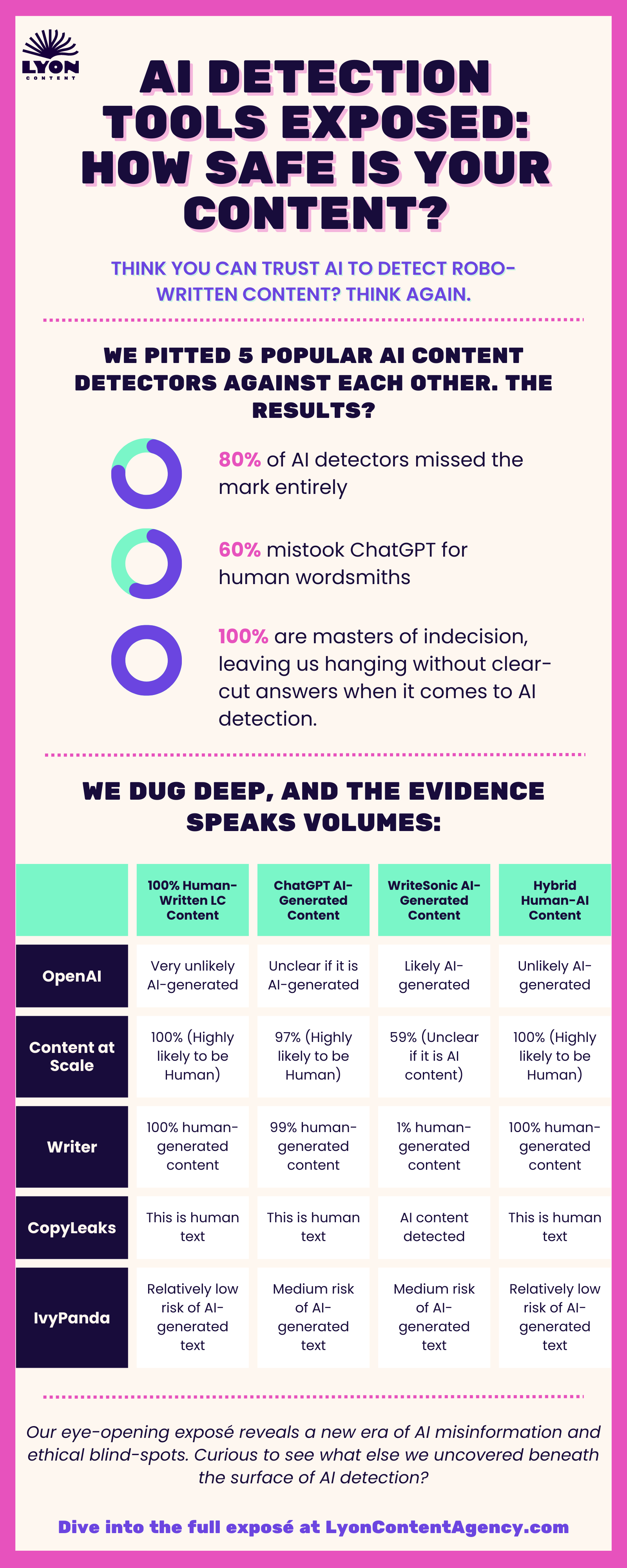
What is an AI content detection tool?
Artificial intelligence (AI) content detection tools are software that leverage AI to analyze and identify AI-generated content. In other words, they help distinguish between content written by humans and “written” by robo-writers.
Wondering why you’d want to differentiate between human-written and AI-generated content?
Sure, AI content generators can churn out loads of content in seconds, often at no cost, but relying solely on AI content writing? That comes with its own set of potential issues that many businesses and organizations would rather steer clear of.
For instance, it can result in unoriginal ideas, a lack of authenticity, ineffective optimization, and even ethical and legal implications.
Christina weighs in:
“The legal ramifications of AI are just beginning to surface, and it’s getting ugly.” She says the software is so novel that many people don’t fully understand how language models work to compile AI-generated content.
Don’t get me wrong—we aren’t blatantly against AI content generators. On the contrary, we see immense potential in harnessing them as tools. However, we firmly believe that human oversight is crucial when utilizing them.
So how do AI checkers work? 🤔
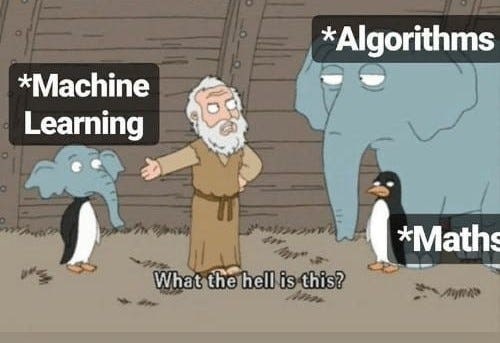
The tech behind AI content detection tools
AI content detectors use various AI techniques to analyze and assess content for different purposes.
As for their techniques, they can include one or a combination of the following:
🤖 Machine learning (ML) algorithms
These detectors learn from massive datasets, often labeled to indicate correct or incorrect content. ML algorithms are applied to this data, allowing detectors to recognize patterns, correlations, and anomalies. By learning from this training data, the detectors can make predictions or classifications about new, unseen content.
🤖 Pattern recognition
Pattern recognition extends beyond ML to include other methods for detecting and interpreting patterns in data. It identifies and interprets regularities, structures, or recurring patterns within data. These patterns can exist in various forms, like visual patterns in images, sequential patterns in time series data, or linguistic patterns in text. The goal? To extract meaningful information from data by recognizing and understanding these patterns.
🤖 Natural language processing (NLP)
NLP enables computers to understand, interpret, and generate human language. AI content detectors utilize NLP to process and analyze textual data (like articles, social media posts, or website content). NLP algorithms help extract meaning, identify patterns, and analyze linguistic features to uncover insights and identify potential AI content.
🤖 Statistical analysis
AI detection tools use statistical methods to analyze and interpret data. They can measure metrics like readability, complexity, sentiment, or similarity to common patterns or examples. With these statistical models, detectors can make informed decisions and assess content quality, potential plagiarism, or adherence to specific guidelines.
🤖 Rule-based systems
Rule-based systems are used in AI content detectors to enforce predefined rules or guidelines. These rules range from basic grammar and spelling checks to more complex regulations, industry standards, or legal requirements. The detectors compare content against these rules to identify deviations or potential violations.
🤖 Deep learning
This subset of machine learning involves training complex neural networks with multiple layers to recognize intricate patterns and relationships within data. Deep learning algorithms have been applied to various aspects of content analysis, like image recognition or language understanding—thereby enhancing the capabilities of AI content detectors.
While different AI content detection tools share some common principles, the specific workings of each can vary. And that, my friends, is what brings us here today.

Comparing 5 free AI detection tools
Given the unique workings of each AI content detector, we’re curious how they stack up against each other when exposing AI-generated content.
Here’s how we tested each AI detection tool:
1️⃣ First, we narrowed down five of the most popular free AI detection tools.
Some of these aren’t free forever or have limited features, but you can put them to the test before making any regrettable commitments.
Here’s who we threw into the ring:
- Open AI
- Content at Scale
- Writer
- CopyLeaks
- IvyPanda
2️⃣ Next, we added the content: 100% human, 100% AI, and a human-AI hybrid
We ran four content pieces (each under 400 characters) through each AI detector.
- First, an excerpt from a 100% human-written Lyon Content article about writing eBooks for content marketing, particularly about how to use audience data to inform your topics.

- Then we had two of the most popular AI content generators (ChatGPT and WriteSonic) write content with the same idea.
Inspired by HubSpot’s recommended prompts, we asked them the following:
In a conversational but professional tone, write 350-400 words on how to use data to inform ebook topics. Include one cited source and actionable steps the reader can take to find topics.
Here’s what ChatGPT generated:
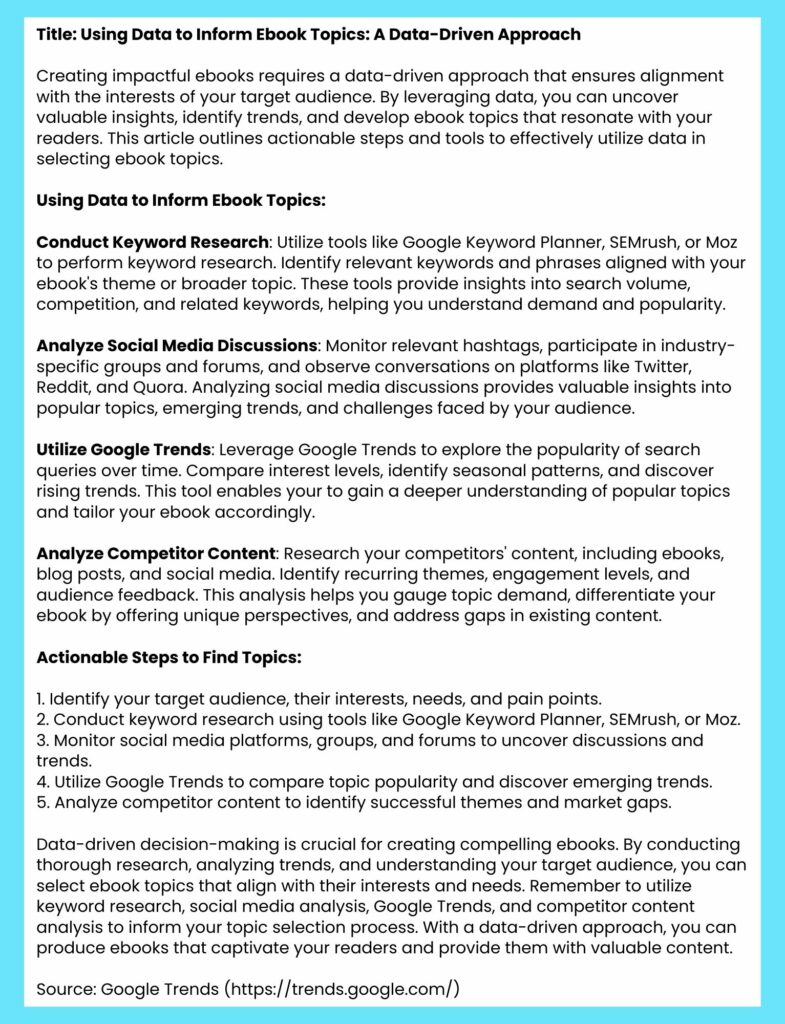
And here’s what WriteSonic came up with:
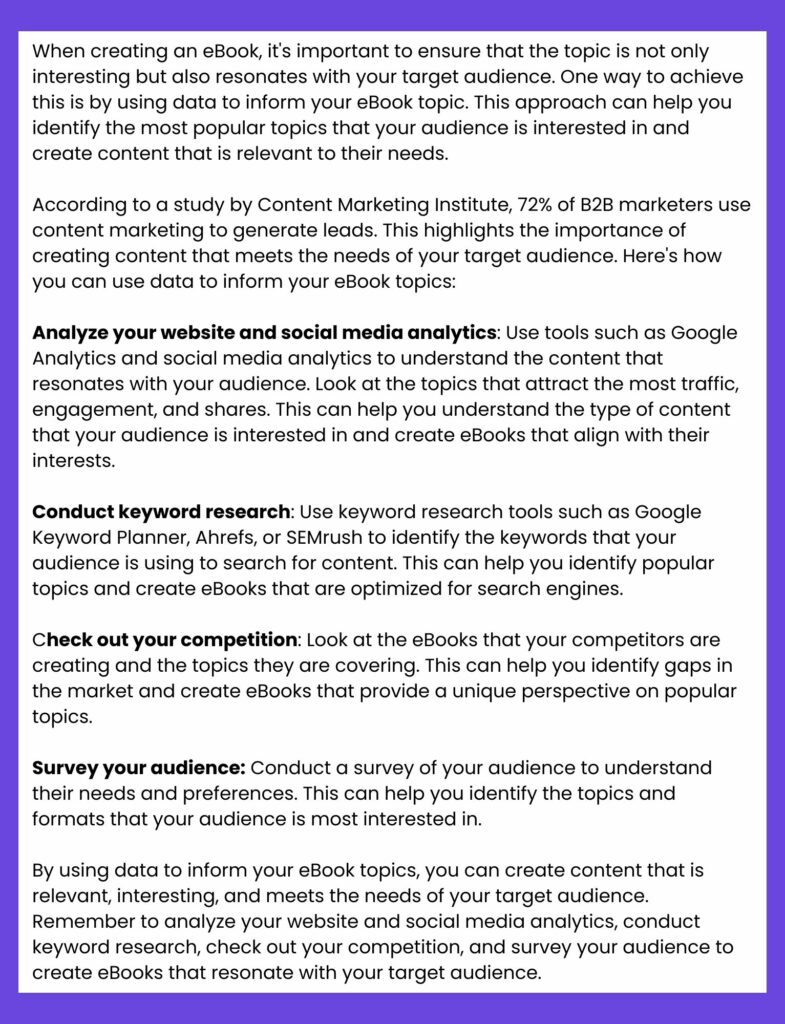
- Last, we cooked up a hybrid piece of content by merging both AI-generated outputs with the expert touch of a writer with a pulse, a.k.a. moi. 🙃
Here’s what we got:
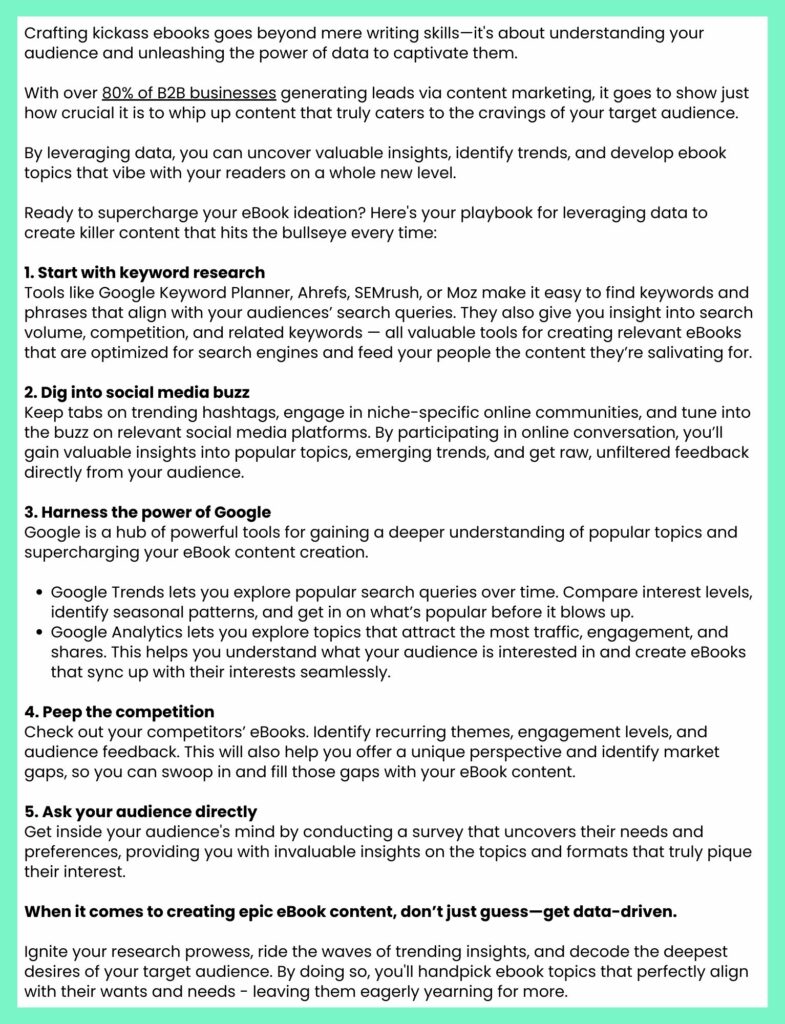
3️⃣ Finally, we ran each piece of content through the AI detection tools and assessed the results, showcased in the following table:
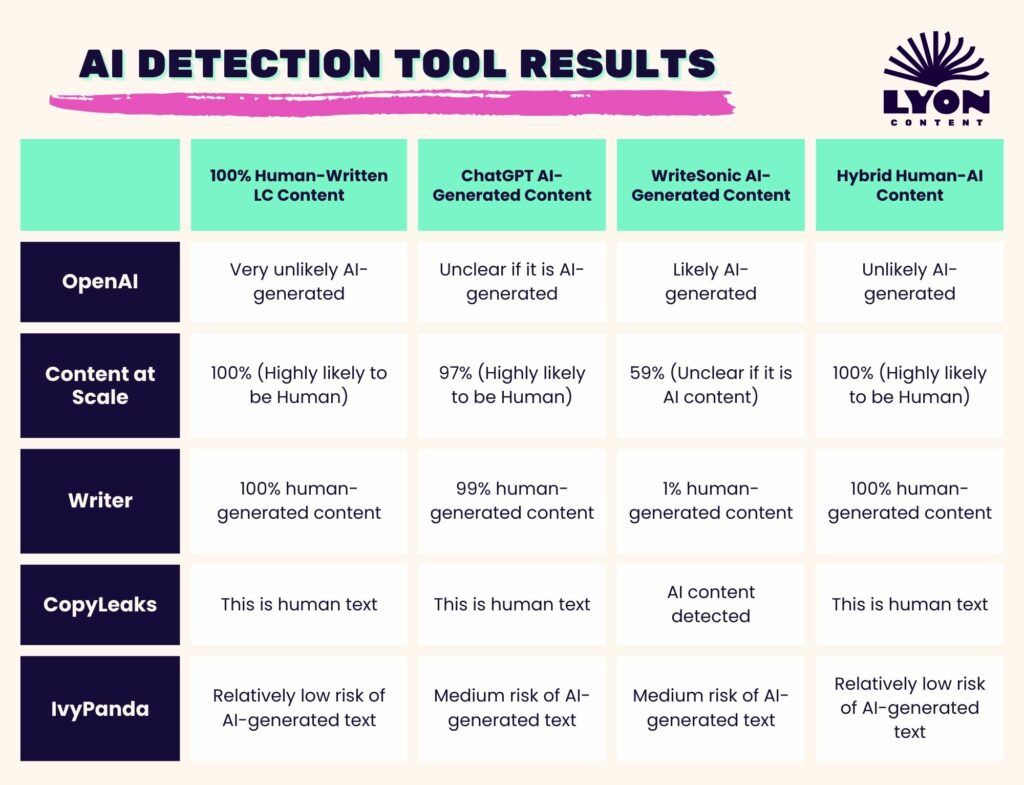
As you can see, the rankings vary, some as percentages and others as textual descriptors indicating the likelihood of AI-generated writing.
Alrighty! Let’s take a closer look at each of these tools and unpack what their scores mean within the larger context.
OpenAI
UPDATE 7/25/23: Since publishing this article, Open AI has subtly shut down their AI detection tool due to “low rate of accuracy” which, based on our results, does not come as a surprise to us.

As the makers of ChatGPT, OpenAI is an OG heavyweight in the world of AI content generators. So when we peeped the headline, “Chat GPT Maker Releases AI Detection Tool,” we knew we had to sink our teeth into this one first.
First, the obvious question: Does ChatGPT’s AI detection tool only detect content generated by ChatGPT?
Nope! OpenAI uses a multi-faceted approach to identify text generated from various AI sources, not just ChatGPT.
According to their site, OpenAI’s detection system is continuously refined and updated to adapt to emerging patterns and changes in AI tech. This ensures the effective detection of AI content in different contexts.
Open AI is also a Google AI detection tool you can integrate into Chrome.
The tool presents itself as a means “to spark discussions on AI literacy.” And they don’t shy away from openly acknowledging their current limitations either.
For instance, it may not catch all cases of AI-generated content, especially as AI evolves. Additionally, it can produce false positives or negatives, meaning it might incorrectly flag legitimate content or miss some AI-generated content.
Let’s be real—these limitations apply to most AI detection tools. It’s just refreshing for OpenAI to be so forthcoming about their constraints, recognizing the ongoing challenges in maintaining a foolproof detection system.
So how does the OpenAI detection tool stack up?
Results
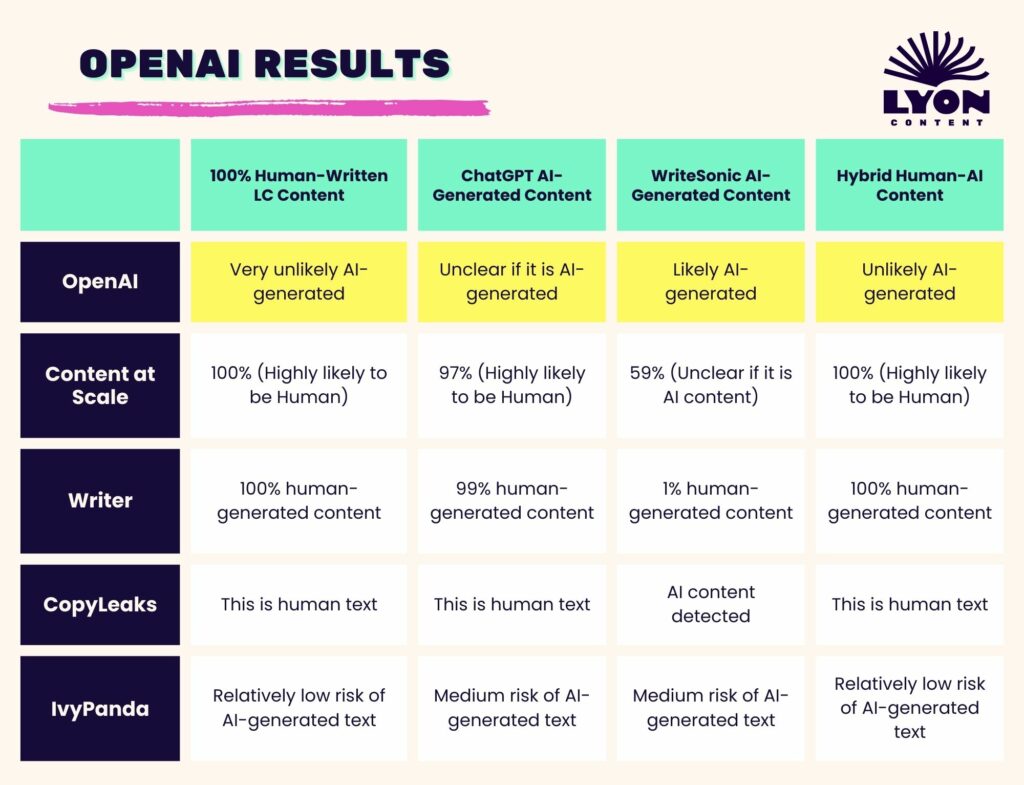
All things considered, the OpenAI detector fared the best compared to other tools. It accurately detected our human-written content as “Very unlikely AI” and fairly ranked our hybrid content as “Unlikely AI.”
It’s also one of two of the only AI detectors that ChatGPT couldn’t quite fool, earning an “Unclear” score. OpenAI was unswayed by WriteSonic’s content, as well.
Our two cents? OpenAI stands strong in the face of AI deception. It’s no surprise, though, considering their model’s the source of most AI-generated content out there today.
That said, they’re transparent regarding their tool’s shortcomings, which likely contributed to it’s undoing.
Content at Scale
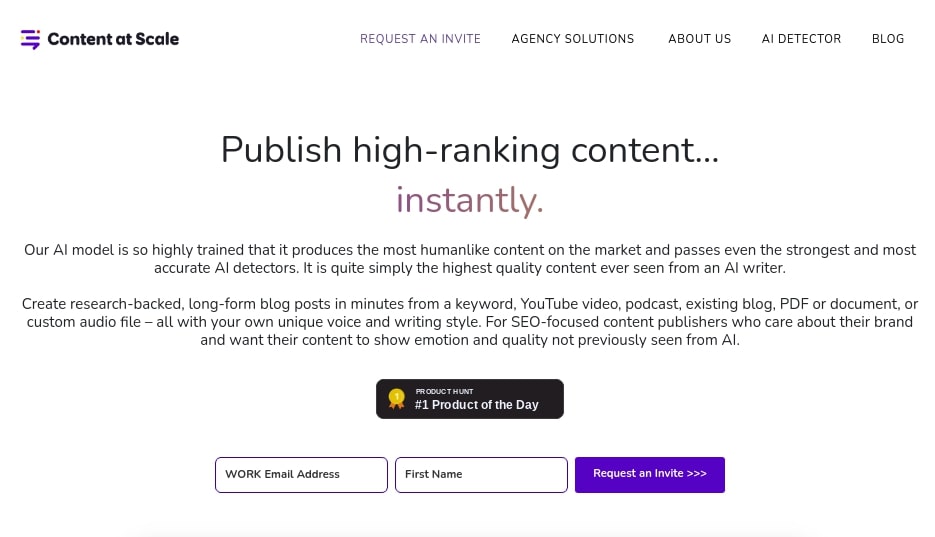
Content at Scale is an AI content generator that promises to write text so “human-like” it can bypass AI detection tools. Their AI detection tool makes equally big claims.
According to their site, it works “at a deeper level than a generic AI classifier” (cough, OpenAI, cough) to detect “robotic sounding content.”
It claims to be trained on vast amounts of data to predict word choices that heighten the probability of AI detection.
In other words, they talk a big game.
I know you sense my cynicism, so let’s check out the results, and you’ll see why.
Results
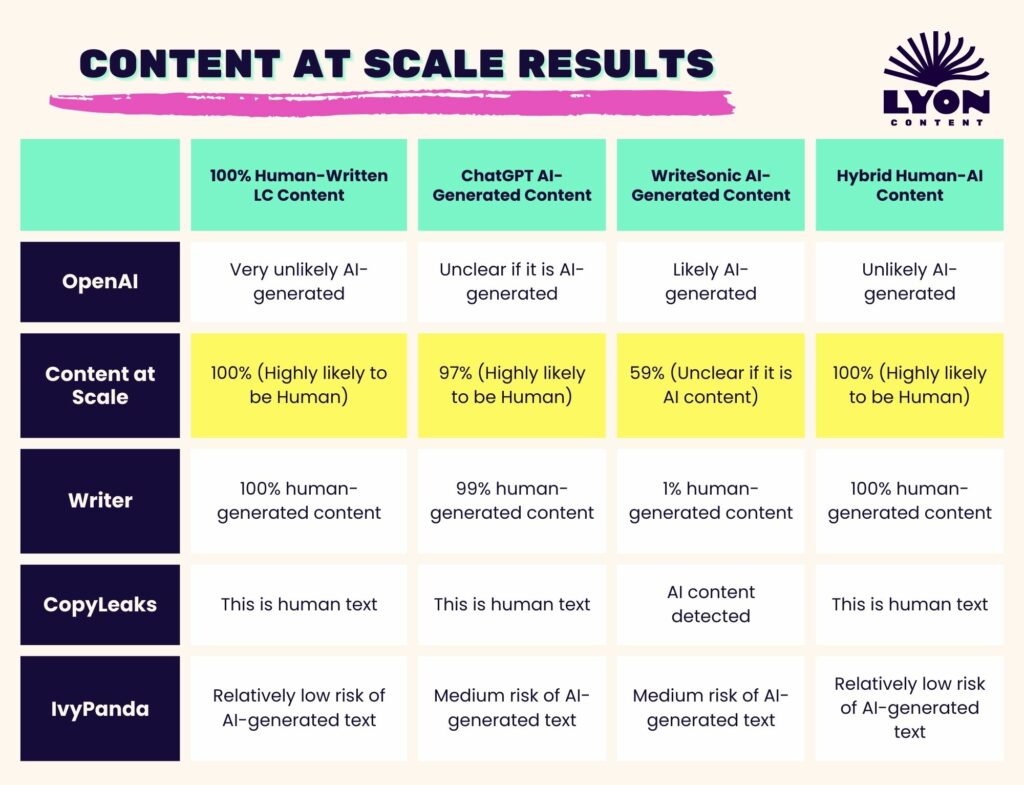
Content at Scale claims their AI detector can analyze and identify content generated by ChatGPT or any AI text generator for that matter.
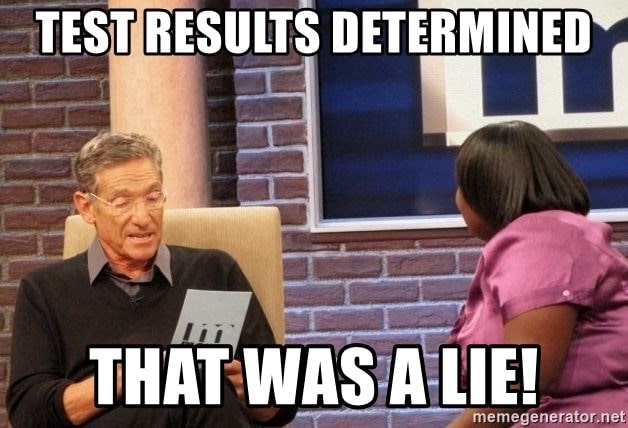
You’ll see as we continue that results like these aren’t uncommon across some AI content detectors. The same can be said for the opposite, too.
Christina has felt the implications of misreadings such as these. “I’ve personally written content 100% myself, ran it through an AI checker, and had it flag 30% of my copy as potentially AI-written.”
This is inevitable, and no writer is immune to getting false AI flags. As writers in content marketing, we prioritize writing easy-to-read, digestible, accessible, and conversational content.
Readability is also on AI writing software’s radar, so more transitional sentences, or conversational elements may be flagged since AI tries so desperately to write naturally (often failing miserably, if we’re being honest).
My beef with Content at Scale? They aren’t just wildly exaggerating their capabilities and taking shots at a rival AI detector (which, by the way, outperforms them). They also audaciously claim they can shield you from future Google updates—a claim that’s not only implausible but contradicts the expertise of anyone with SEO experience.
Writer
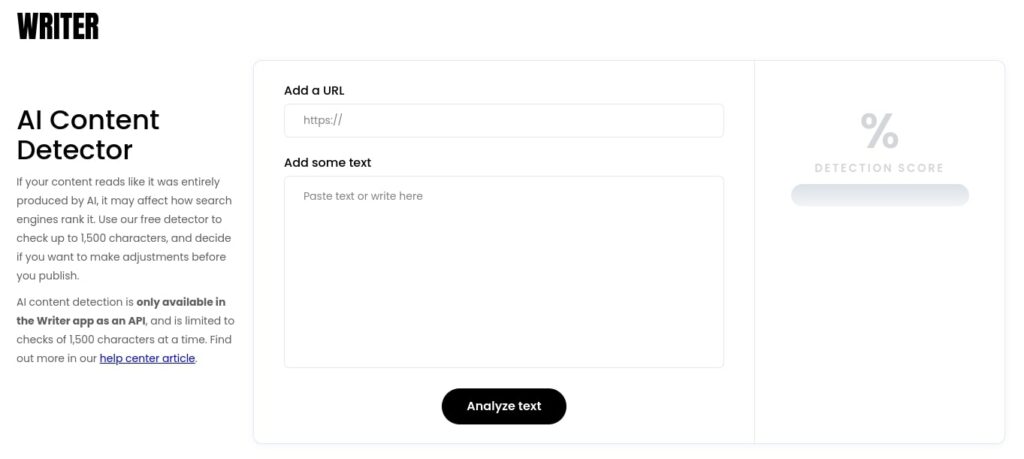
Writer touts itself as an “enterprise AI” able to assist with almost all aspects of content strategy—from content generation and style guides to security, privacy, analytics, and more.
The Writer AI detection tool, which seems to combine machine learning algorithms and pattern recognition, feels like it’s geared more toward lead generation than comprehensive AI detection.
One immediate downside? Writer won’t let you submit content with more than 1500 characters at a time. So if you’re working with longer pieces of content, you’ll have to break it up to run it through the AI detector.
Most AI detectors emphasize the importance of longer text for more accurate AI detection, so it’s interesting that Writer caps your input at just 1500 characters.
On that note, how does Writer stack up against other AI content detection tools?
Results
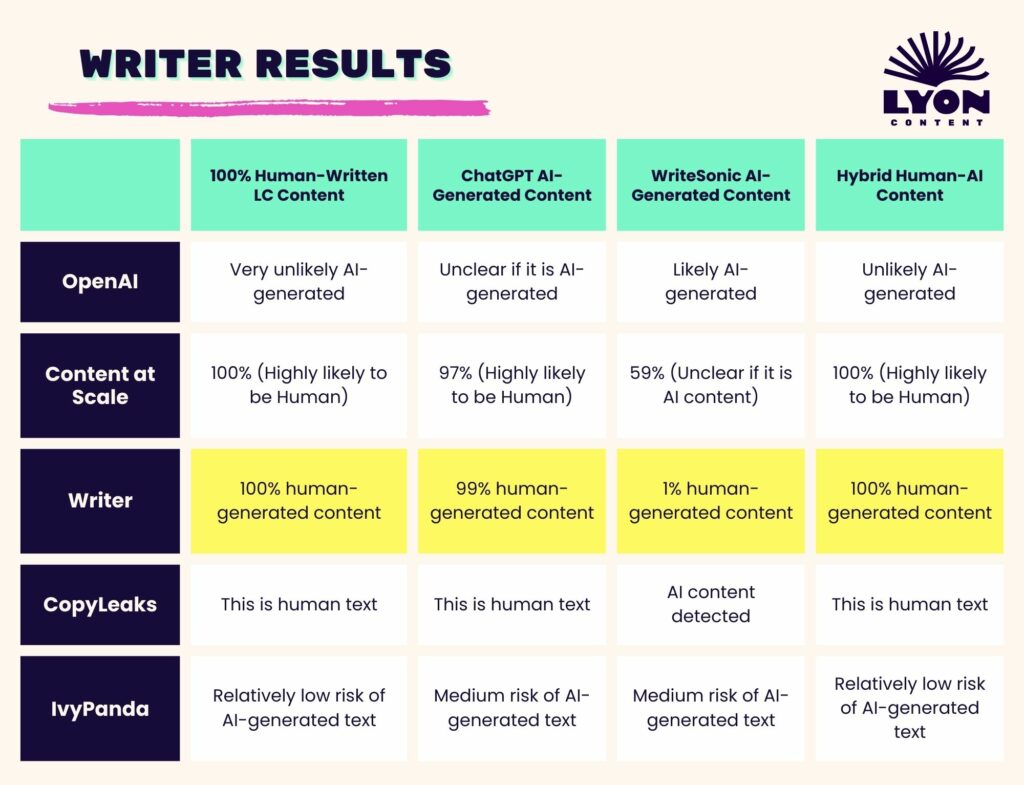
Writer successfully identified our human-written content and flagged WriteSonic’s AI content. However, it ranked ChatGPT as 99% likely to be written by a human. 😬 Even our hybrid content received a 100% human-written score, though it’s possible my extensive reworking might have had some influence.
It’s also worth noting that Writer’s AI checker didn’t enter the scene until after the introduction of ChatGPT and the GPT-3.5 update. These updates introduced improvements and enhancements to the underlying AI models, allowing them to generate more sophisticated and contextually accurate content.
As a result, Writer—which was developed prior—may not have the same level of proficiency in handling recent developments in AI-generated content as other detectors.
CopyLeaks
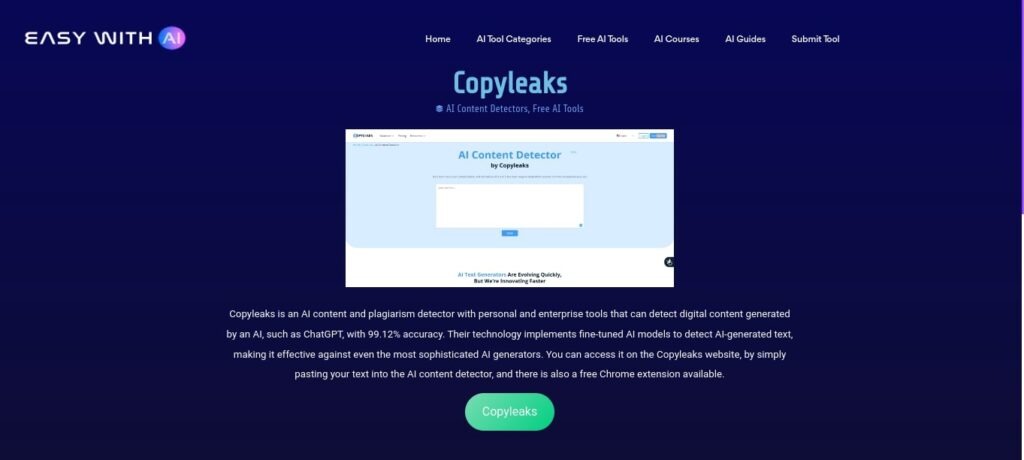
CopyLeaks is one of the most popular plagiarism detectors out there. It’s no surprise they’ve come out with their own AI checker.
According to their site, CopyLeaks evaluates linguistic patterns, word or idea repetition, and structural components.
Alon Yamin, CEO and co-founder of CopyLeaks claims, “With 99% accuracy, we’re able to combat the dark side of AI by uncovering AI-digital DNA crumbs that are left behind, which only sophisticated AI like what we’re using is capable of detecting.”

No shade to my man, Yamin, but we’ve heard this before.
We’ll let the results speak for themselves, shall we?
Results
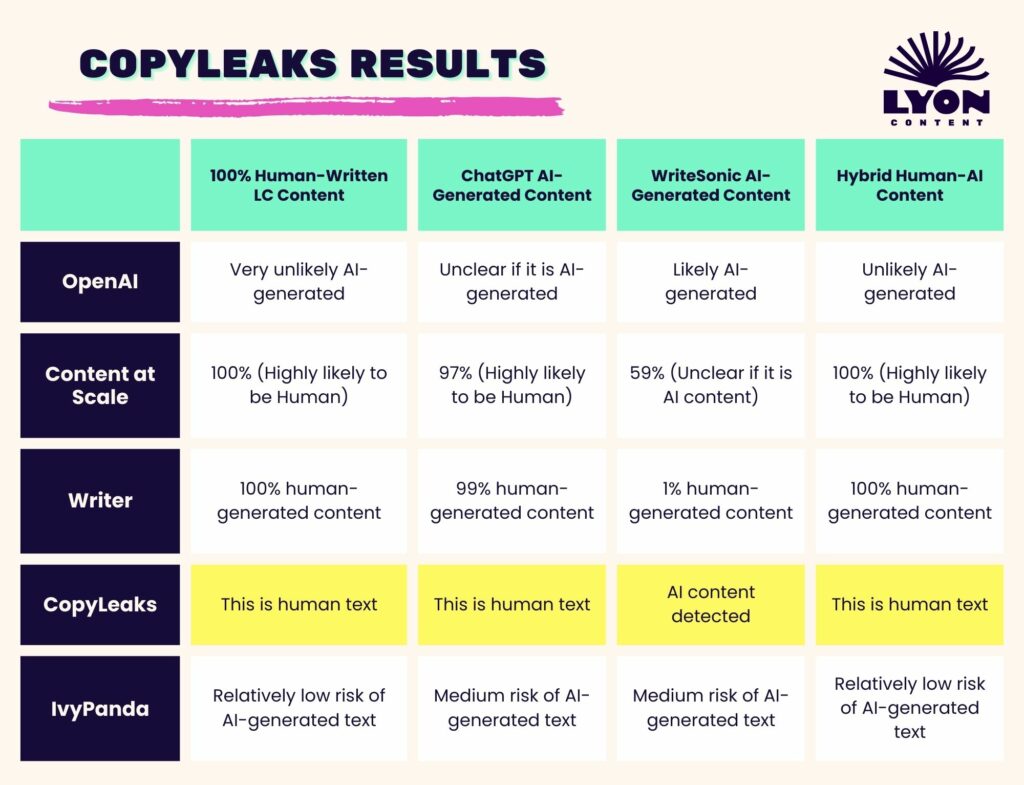
While CopyLeaks flagged WriteSonic’s content, ChatGPT once again fooled this AI detection tool into thinking it was “human text,” along with our human-written content and hybrid content.
Why is this risky? For starters, you might unknowingly share content that breaches ethical standards, infringes upon intellectual property rights, or even exposes you to accusations of plagiarism.
The fallout: A tarnished reputation, diminished credibility, and the looming possibility of legal repercussions.
Christina points to how this is currently playing out with AI-generated art.
“Getty is suing Stability AI, and now, news outlets are claiming AI generators are using their work to train the AI. The copy may be plagiarism-protected and avoid copyright laws, and regurgitation isn’t necessarily illegal, but there will certainly be muddy IP issues, which is why a company should care about more than just plagiarism and prioritize thought-leadership and original content.
You cannot create thought-leadership content from a robot that compiles its thoughts from other people.”
IvyPanda
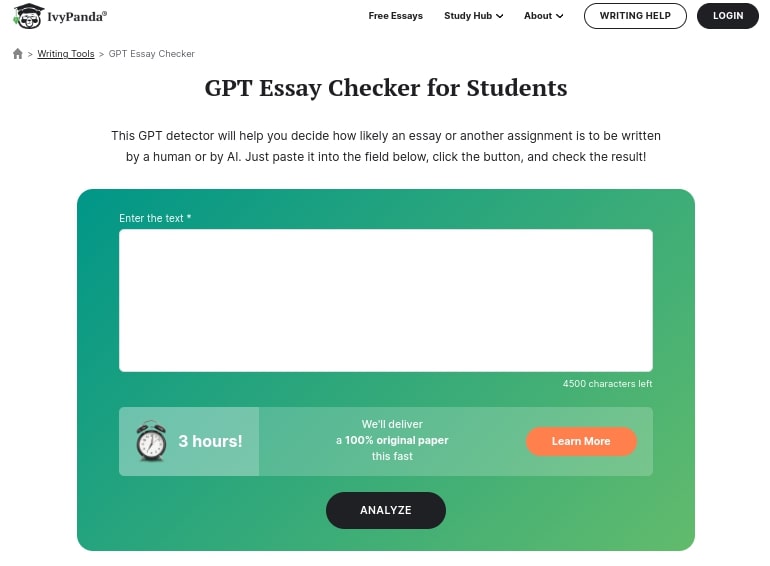
You didn’t think we’d forget about our academic baddies, did you?
TurnItIn has been known as one of the most popular plagiarism checkers used by teachers worldwide for years. They recently hopped on the bandwagon and integrated their own AI detection tool, but TurnItIn isn’t free and doesn’t let teachers demo it before committing.
And let’s face it—teachers are too undervalued to shell out money on a tool they may not even find helpful.
Kind of an ick if you ask me. 😬
Enter: IvyPanda, another go-to AI detection tool for essays and academic writing. While not quite as known as other paid tools, IvyPanda is definitely a heavy-hitting rival of the TurnItIn AI detection feature.
Unlike TurnItIn, however, IvyPanda lets you scan content as long as 4500 characters completely free. It even breaks down AI text probability word for friggin’ word.
Pretty cool for a free tool, eh, Teach?
And I must say, we were pleasantly surprised with how IvyPanda held its own against other AI detection tools.
Results
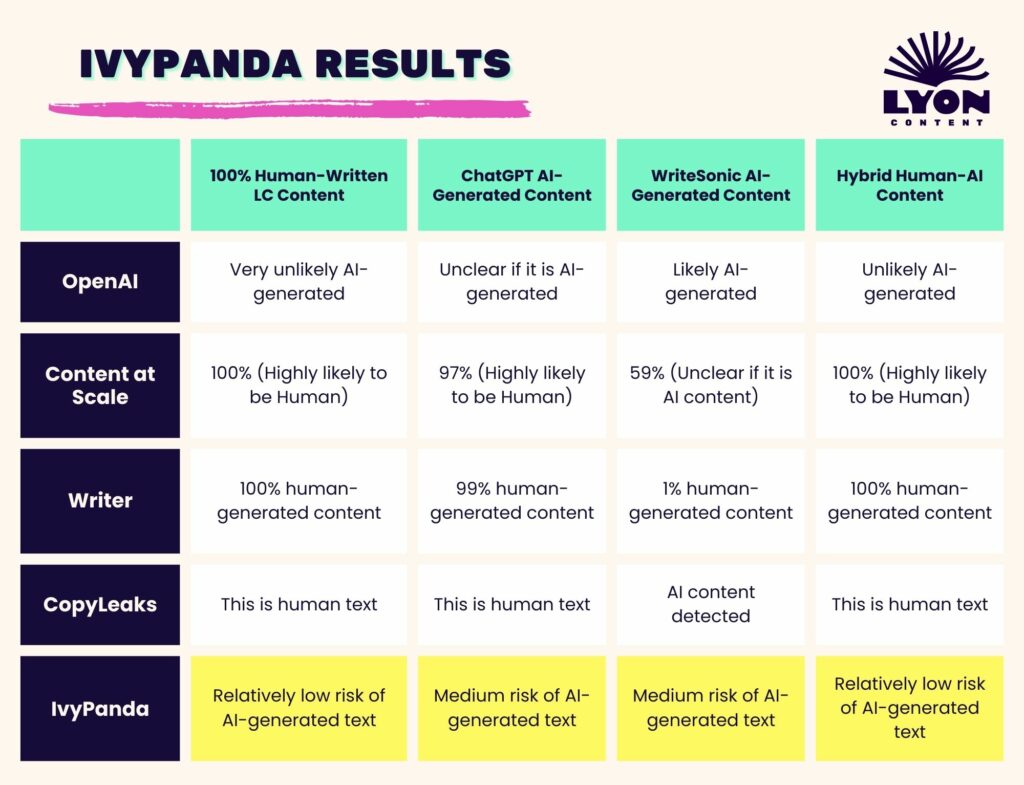
Something to bear in mind when looking at these results: IvyPanda is geared towards detecting AI in academic writing, which is incredibly different from writing for content marketing. There are different rules, structural features, randomness “footprints,” and so on.
Even so, IvyPanda rose to the occasion. It fairly ranked our human-written excerpt and hybrid content as “relatively low-risk for AI-generated text,” which isn’t untrue.
Surprisingly, it’s the only AI detection tool besides OpenAI to flag both ChatGPT’s and WriteSonic’s AI content.
Look at you go, IvyPanda. 🐼
But as impressive as these results may be, Christina cautions, “These tools should be used carefully. There are instances of AI detectors incorrectly flagging students’ original work.”
With that in mind, educators must exercise caution when using AI detectors.
Alright, alright—having said all that, one question remains…
In the battle of AI detectors, which one reigns supreme? 👑
The best anti-AI detection tool
As we’ve learned, no AI detection software is 100% perfect.
But if we had to pick, we’d crown OpenAI or IvyPanda. They’re the only AI checkers that accurately detected AI writing across both ChatGPT and WriteSonic.
The truth is OpenAI likely possesses an advantage in deciphering the output of their own models. There are even speculations that they might introduce content watermarking (a piece of code into the text generated).
IvyPanda, which is geared towards academia, goes the extra mile by breaking down words and phrases in your text that are likely AI-generated—a competitive feature setting it apart from other free AI detection tools, including OpenAI.
As for which is best for you, it ultimately boils down to your content needs and specific biz goals. Just remember to keep their limitations in mind when using them.
AI detection tools: the good, the bad, the murky
In theory, AI content detectors have the potential to revolutionize the way we identify content that’s duplicated, regurgitated, plagiarized, inadequately optimized, or lacking authority—the list goes on.
But that’s only if they work the way they’re supposed to. And as we’ve seen today, many of them fall way short of their grandiose promises, stumbling far from the mark of their intended functions.
So, can we put our complete trust in AI checkers? Not quite, or at least not yet, anyway.
Our pack leader weighs in, “If a company wants to save costs by choosing an AI-human model, they should clearly outline terms and guidelines for how to use AI content with human oversight.”
In other words, take a page from OpenAI’s book and lay it all on the table.
“For example, clarify your processes for fact-checking, authenticating claims, and updating research to be recent and relevant. Ensure your team isn’t simply taking AI-generated copy at face value and hitting publish.”
Then there’s the issue of bias.
“There may be an embedded narrative and agenda to AI’s created content, which is pulling from large demographics and majorities, potentially suppressing minorities and even erasing historical facts,” explains Christina. “It’s all very ethically gray, and as business owners, we’re responsible for prioritizing diversity and inclusion. That can’t happen when using a robot to create your content.”
The magic ingredient? Human oversight, always.
Dodging penalizations and preserving the artistry
How can you stay ahead of low-quality AI content or potential misinterpretations by AI detection tools?
“Brands need to collaborate with reputable, trusted writers with a proven track record for producing high-quality content exhibiting empathy, compassion, and personality—all things you won’t find from AI content.”
Otherwise, we risk long-term repercussions on the quality and diversity of the content ecosystem—all thanks to the prevalence of AI-generated content.
As noted by Christina, “We could very potentially be marching toward sameness. If everyone chooses to have ChatGPT generate their work, then we’re all just saying the same thing in so many words, right?”
Boringgggg. 🥱
“Free thinking, artistry, and innovation are at risk, but I still believe that human thinking and ideas reign supreme, so long as brands continue to establish themselves as true thought-leaders, and creators continue to, well, create.”
Lyon Content: Crafted by hand, not by code
In today’s dynamic content landscape, the key to success lies in striking a balance between human creativity and the potential of AI assistance.
Leveraging powerful AI detection tools, like the ones we’ve delved into today, businesses and content creators can unlock new realms of productivity and efficiency. However, this balance is achieved only when these tools work the way they’re meant to.
At Lyon Content, we understand the importance of cherishing the artistry, empathy, and distinctiveness that only human minds can generate.
“All our writers have agreed to our updated terms, which reflect that we are strictly against the use of assistive AI writing tools like ChatGPT. We’ve also updated our client contracts to reflect that we agree to these terms and will never employ AI for creating their content.“
As the content landscape continues to evolve, we remain at the forefront, empowering brands with authentically unique, human-written content that goes beyond the mass-produced, AI-created clutter inundating the internet today.
Ready to shake sh*t up and join the content revolution?
Peep our services or set up a chat—together, we’ll unleash your brand’s full potential and craft extraordinary content that launches you into a league of your own. 💥

FAQs
Can AI writing be detected?
Yes, AI writing can often be detected. AI-generated content usually falls flat, lacking the complexity and nuances that only human writers can execute. Additionally, it’s often riddled with grammar and syntax errors, indicating it’s not written by an actual person. Lastly, AI content generators are known to repeat certain words and phrases. All of these are dead giveaways to AI detection tools.
Is there a tool to detect AI writing?
Yep, there are many anti-AI detection tools, with new ones emerging all the time! Some of our favorites include OpenAI, IvyPanda, and Writer.
What is the best AI detection tool?
If we had to pick, we’d probably crown OpenAI or IvyPanda. They’re the only tools that accurately detect AI writing across ChatGPT and WriteSonic. Both tools are free to use, boasting impressive features and user-friendly interfaces that make AI content detection a breeze.
Why should you check your content for AI?
For starters, it’s all about maintaining authenticity and credibility. With the rise of AI content generators, ensuring your audience can trust that your words are genuinely yours is an edge you don’t want to relinquish. By checking your content for AI, you safeguard against potential misinterpretations, plagiarism, or legal concerns and avoid getting lost in the sea of generic, machine-generated words.
How does AI writing detection work?
AI detection tools employ various AI techniques, like machine learning algorithms or natural language processing, to analyze content and flag AI.
Can Google detect AI-written text?
Google employs the same techniques as AI checkers, along with more sophisticated algorithms and data analysis, to flag patterns and characteristics indicative of AI-generated text. It can also flag plagiarism and duplicate content.
This is why brands must align their content with Google’s standards and self-established quality benchmarks. That way, they craft content that captivates and fosters loyalty among their human audience and garners the buy-in and engagement they desire.
How do I bypass AI detection tools?
At Lyon Content, we’re strictly against using soulless AI to generate content for our clients, but that doesn’t mean writing with AI is inherently bad—so long as you top it off with a hefty dose of human finesse.
To bypass AI detection tools, you’ll need to breathe life into the robotic gibberish with some strategic edits. Inject personality, wit, and polish those soulless words until they dance with the essence of humanity.
Or better yet, hire a kickass wordsmith to infuse your content with a vibrant pulse that defies the limitations of AI-generated mumbo-jumbo.

07/25/2023
Natalie is a beauty and lifestyle writer at Lyon Content, born and raised in sunny Miami, Florida. She’s passionate about crafting personality-driven copy that helps brands build a ride-or-die following with their audiences! Like a true Cuban, she runs on XL cafe-con-leches and loves horror movies, houseplants, exploring new places, and snuggling up with her SO and fur babies.


